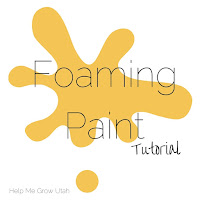Science experiments at home are a great way to teach children. Kids are naturally curious, so providing them with opportunities to explore and grow will help them learn more about the world around them.
Foaming paint is a fun way to show your child about how 2 ingredients can interact with each other to make a fun reaction! The recipe is simple and is sure to be a hit with the whole family.
I found this idea on Learn Play Imagine, and she has some great photos! I slightly adapted her tutorial; keep reading to see how it turned out!
Supplies: You will need something to make the paint in, baking soda, white vinegar, food coloring, spoon (not pictured), whisk, 1 Tablespoon measuring spoon, paintbrushes, and card stock or other thick paper.
- Measure 5 Tablespoons baking soda into each bowl.
- Add liquid food coloring to each bowl. We used about 7 drops. Add more as you go for more intense color.
- Add 3 Tablespoons of water and mix well with the whisk. These are the measurements we used for each color, and it made plenty of paint.
- The baking soda will settle to the bottom.
Now it’s time to get creative! Have your little one practice their fine motor skills by drawing small designs, or let them be creative with their painting. Just remember that there will be a lot of liquid with this project, so the thicker the paper, the better. After they are done painting their masterpiece, take a spoon and slowly start dropping the vinegar onto the paint. Watch as it starts to sizzle and foam!
In order to get a good reaction, we ended up stirring the paint as we went and scooped the baking soda with our paint brushes onto the paper. This is where a more substantial brush would have come in handy. The original tutorial calls for pipettes to distribute the vinegar onto the paper, but we didn’t have any so we just used a spoon. The sound it makes when the vinegar reacts with the baking soda is almost more fun than seeing it!
Tips for Success:
- I played with the measurements of the baking soda to water ratio. This is what worked for us, but it doesn’t have to be exact. Just remember, the more baking soda that makes it onto the paper, the more of a reaction you’ll get when adding the vinegar.
- We used little flimsy paint brushes from a child’s paint set. A bigger, sturdy brush may work better for getting that thick baking soda mixture onto the paper.
Comment below to let us know if you try this, or what some of your other favorite science or art projects are!
-Amanda




No comments:
Post a Comment
Note: Only a member of this blog may post a comment.